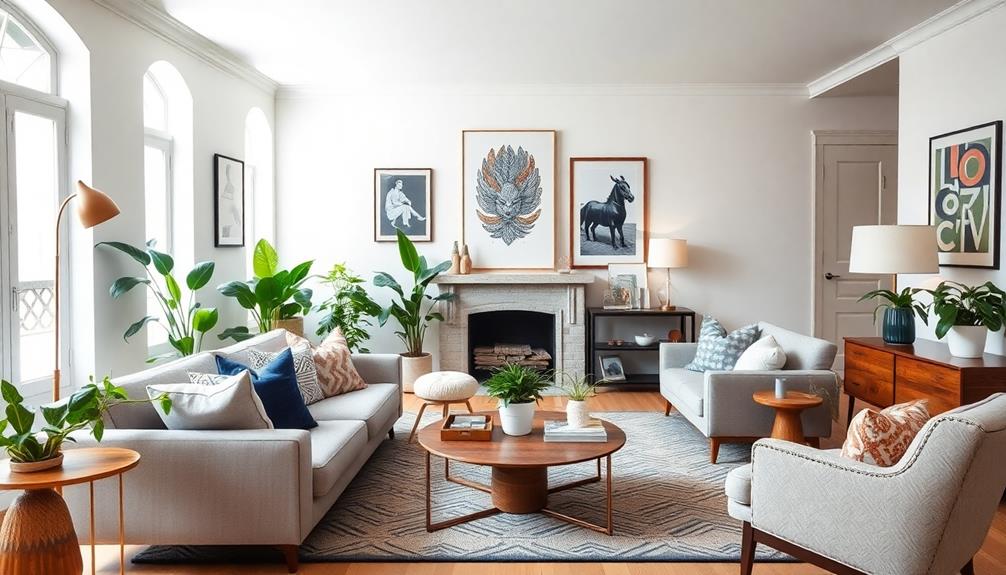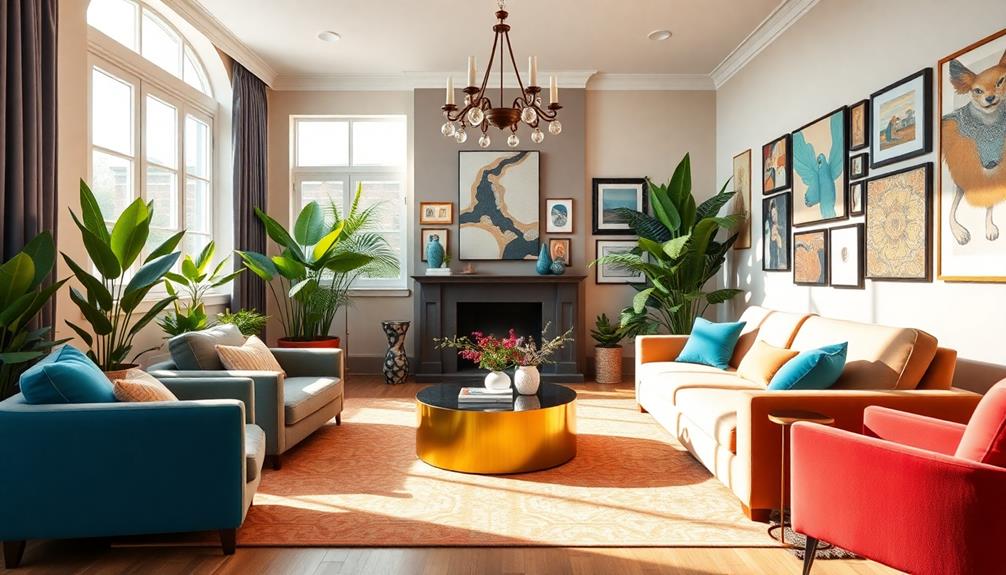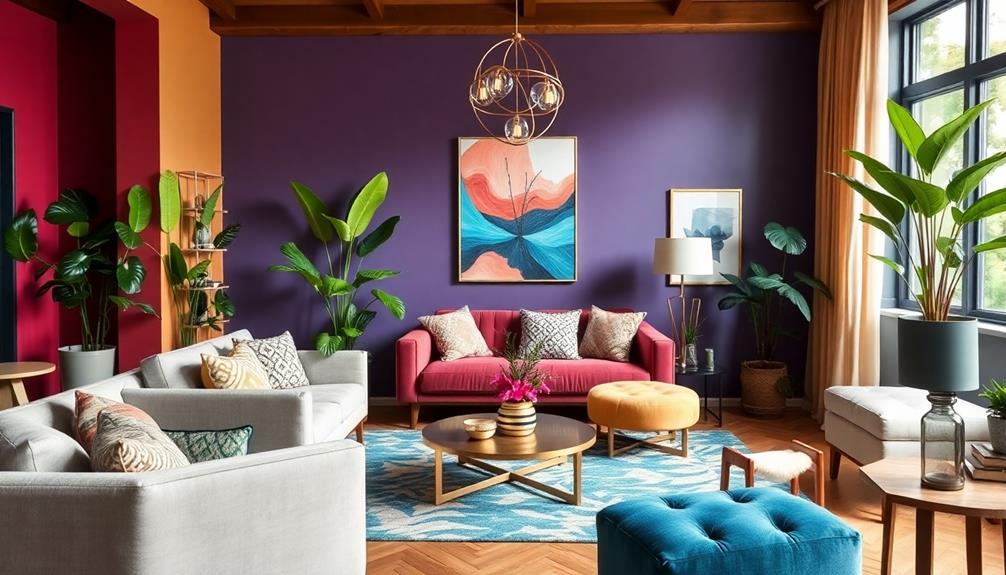To style your home like an interior decor expert, start by establishing a budget and creating a mood board filled with your favorite colors and textures. Select an inspirational object to unify your theme and plan a room layout that promotes flow. Choose high-quality, versatile furniture pieces and decide on a cohesive color scheme. Layer different textures to add depth and comfort, and don't forget to personalize your space with unique decor. Finally, optimize lighting to enhance the ambiance. These foundational steps set the stage for a beautifully styled home, and there's so much more detail to explore! Expert tips for interior decor also include paying attention to the scale and proportion of your furniture and decor, as well as incorporating elements of nature, such as plants or natural materials, to bring life and balance to a room. Additionally, considering the function of each space and incorporating storage solutions can help maximize both the aesthetic and practical aspects of your home decor. By following these expert tips for interior decor, you can create a stylish and personalized space that reflects your unique taste and personality. By incorporating these tips and tricks, you can achieve a balanced interior decor that is both visually appealing and functional. Consider adding accent pieces, such as throw pillows, rugs, and artwork, to tie the room together and add a pop of color or pattern. Pay attention to the scale and placement of these elements to ensure they enhance the overall aesthetic without overwhelming the space. Finally, don’t be afraid to experiment and make adjustments as needed to create a space that truly feels like home.
Key Takeaways
- Establish a clear design budget, prioritizing must-haves and including a cushion for unexpected expenses to guide your spending.
- Create a mood board to visualize your design inspiration, utilizing colors, textures, and materials that reflect your desired aesthetic.
- Select a unique inspirational object to anchor your design theme, guiding color palettes and ensuring cohesiveness with existing decor.
- Optimize room layout for traffic flow and furniture functionality, using scaled drawings or apps for effective planning.
- Incorporate layered lighting techniques, including ambient and task lighting, to enhance the ambiance and highlight key design features.
Establish Your Design Budget
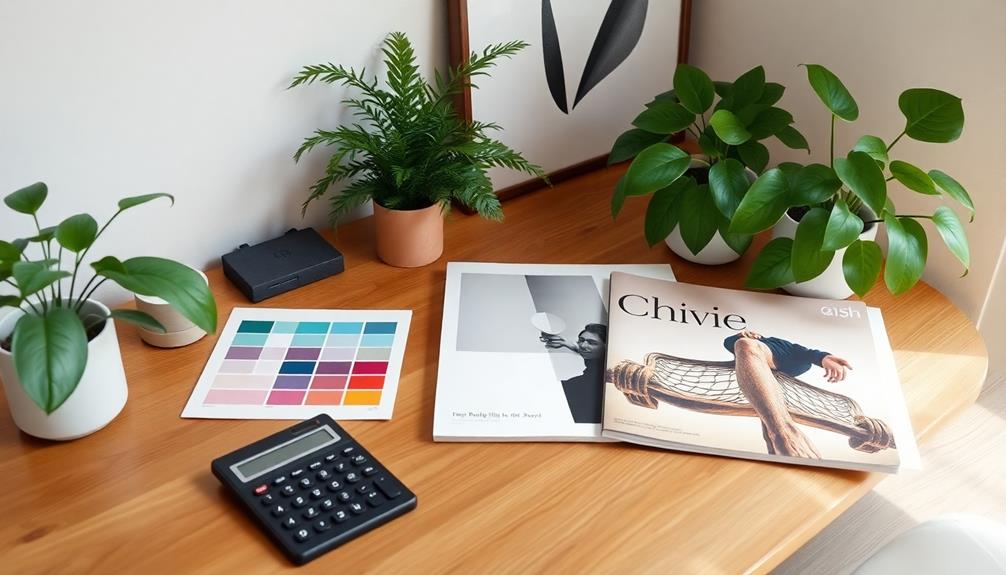
Setting a clear design budget is essential for any home styling project. You need to prioritize expenditures into must-haves, nice-to-haves, and not priorities. This method helps you effectively manage remodeling costs while guaranteeing your home decor reflects your style.
Additionally, consider exploring modern Indonesian housing trends for inspiration on eco-friendly materials and smart designs. Start by creating a detailed spreadsheet that outlines all project elements and their costs. Don't forget to include a cushion of 10%-20% for unexpected expenses. This will help you avoid financial surprises along the way.
To make informed decisions about your budget allocation, obtain at least three contractor bids. This will allow you to compare costs and assess quality, guaranteeing you're getting the best deal.
Before purchasing furniture pieces, prepare accurate measurements and layout drawings to ensure they'll fit well within your space. This not only maximizes your design impact but also keeps you within your budget.
Lastly, remember that an effective budget accounts for ongoing maintenance costs and potential future upgrades. By planning ahead, you guarantee the longevity of your modern design choices while achieving a home that's both stylish and functional.
Create a Mood Board
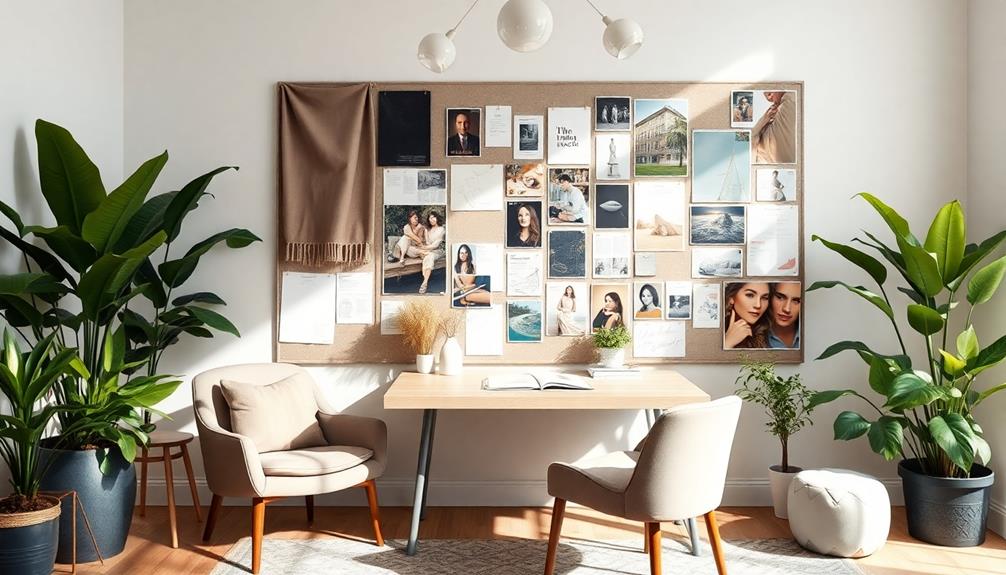
Once you've established your design budget, the next step is to create a mood board that captures your vision for the space. Start by gathering design inspiration from magazines, Pinterest, and even nature. This will help you identify the overall feel you want. Choose a springboard object that resonates with your personal style; it'll guide your color schemes and design choices.
To create a visual representation of your ideas, use a combination of images, fabric swatches, paint samples, and flooring options. Guarantee all elements work harmoniously together by organizing your mood board into groups based on similar colors and textures. This approach allows you to see how different components interact in your final design.
Here's a simple table to help you visualize your mood board elements:
| Color Scheme | Texture | Design Inspiration |
|---|---|---|
| Soft Neutrals | Linen & Wood | Nature-Inspired |
| Bold Jewel Tones | Velvet & Metal | Modern Art |
| Earthy Tones | Stone & Canvas | Rustic Charm |
Regularly revisit and revise your mood board as your ideas evolve. It's a dynamic tool that refines your vision before making any purchasing decisions.
Select an Inspirational Object
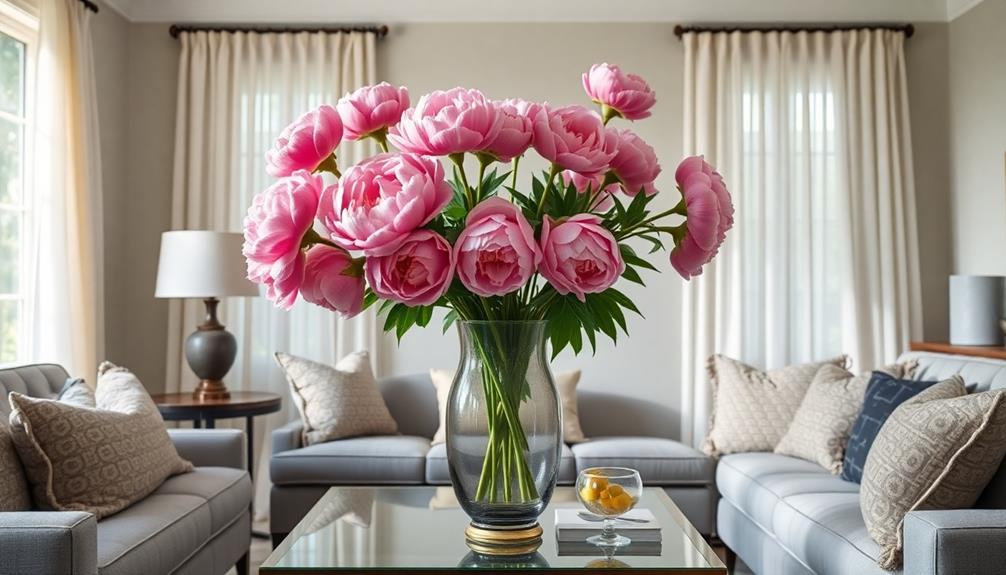
Selecting an inspirational object is essential to establishing your design theme and can greatly influence the overall aesthetic of your space. Choose a unique piece of art, a vintage find, or a statement furniture item that resonates with your personal style. For instance, an Indonesian decorative pillow with vibrant colors and intricate patterns can serve as a vibrant focal point in your living area. This object will serve as the foundation for your design scheme.
Ensure that your chosen inspirational object complements the overall aesthetic while integrating well with existing decor to create a cohesive look. Use it to guide your color palette and texture choices, drawing on its hues and materials to cultivate a harmonious environment.
Pay attention to the scale and placement of the object within the room. It should enhance the flow and accessibility of the space, drawing attention without overwhelming the area.
Incorporate additional elements that reflect the essence of your inspirational object, such as matching colors or similar materials. This will reinforce its influence throughout your design scheme, creating a unified and inviting atmosphere.
Plan Your Room Layout
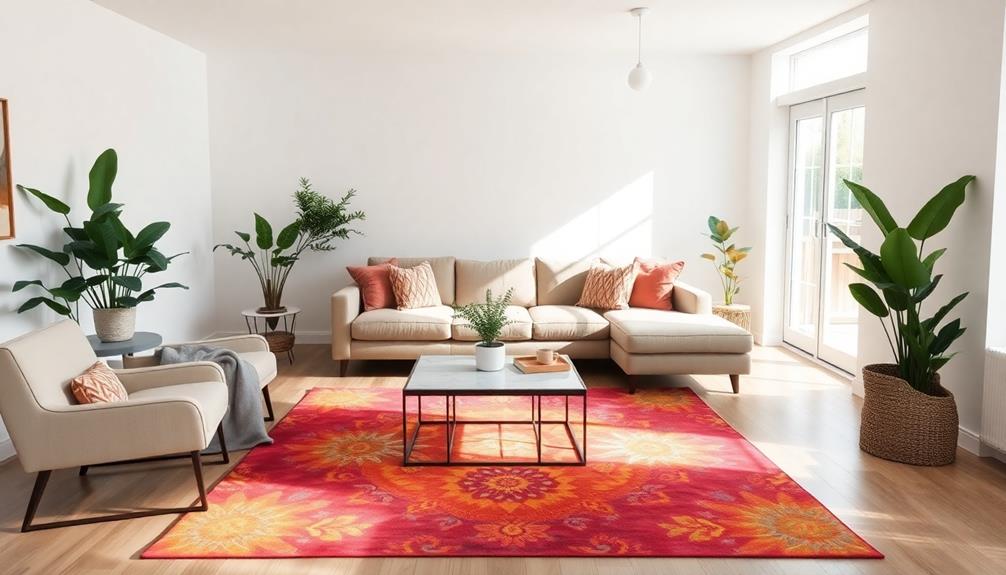
To create a functional and inviting space, start by measuring your room accurately, including all doors and windows.
With these dimensions in hand, you can design a layout that promotes smooth traffic flow and accommodates your furniture effectively.
Consider incorporating space maximization and organization hacks to make the most of your area.
Measure and Design Layout
Getting started with your room layout requires careful planning and measurement. Begin by taking accurate measurements of your space, guaranteeing you know the dimensions of the room and any furniture pieces you plan to use. Creating a scaled drawing with graph paper or a floor planner app can help you visualize the layout effectively.
Consider the intended function of your room and prioritize accessibility. Make sure pathways are clear, allowing for ideal traffic flow. Here's a simple table to help you organize your layout planning:
| Element | Description | Notes |
|---|---|---|
| Measurements | Room dimensions | Accurate is key |
| Furniture Pieces | Versatile, functional pieces | Maximize space |
| Aesthetic | Style and color cohesion | Guarantee harmony |
Once you've mapped everything out, establish a detailed spreadsheet of costs, adding a cushion of 10%-20% for unexpected expenses. Don't forget to get at least three contractor bids to compare costs and gain insights into ideal layout strategies. This preparation will enhance both the functionality and aesthetic of your space.
Traffic Flow Considerations
Establishing effective traffic flow is essential for creating a functional and inviting room layout. To start, focus on furniture placement that allows for clear pathways. Aim for at least 24-36 inches of space between pieces to guarantee comfortable movement.
Consider incorporating natural materials like wood and stone, as seen in traditional Indonesian style home decor, to enhance both aesthetics and functionality. Think about the room's purpose; for instance, if it's a living room meant for conversation, arrange seating to foster interaction.
To help visualize your layout, use graph paper or free floor planner apps. This way, you can identify potential congestion areas before moving any furniture. Pay close attention to door swings, windows, and walkways to avoid obstructions that disrupt the flow.
In smaller spaces, consider incorporating multi-functional furniture, like ottomans or side tables, which can enhance versatility while keeping the flow unobstructed.
Choose Foundation Furniture
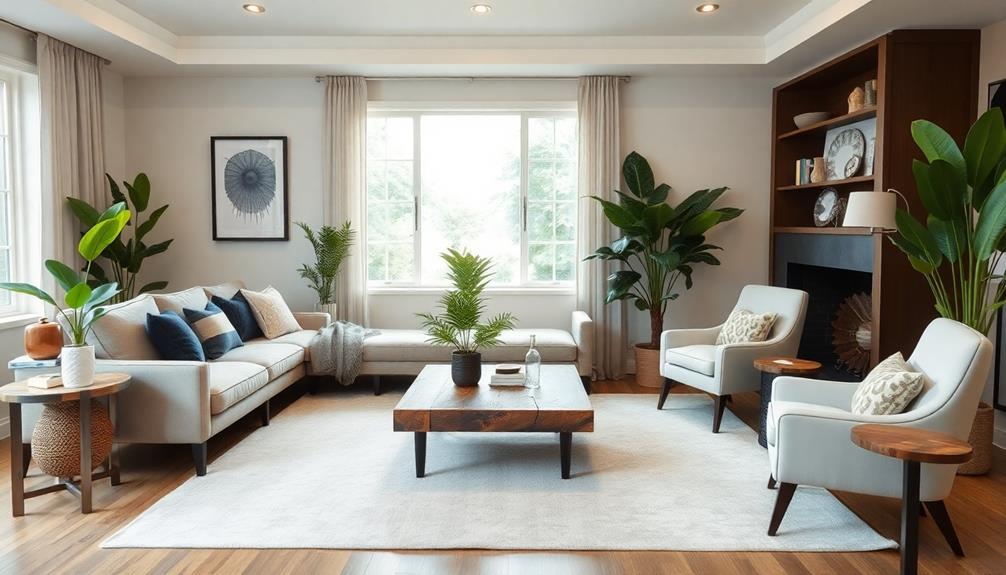
Foundation furniture serves as the backbone of your home's design, providing both structure and style. When choosing these essential pieces, focus on high-quality options that guarantee durability while aligning with your overall design theme. This creates a cohesive aesthetic throughout your space.
Consider versatile furniture that adapts to your needs. For instance, a sofa bed or an extendable dining table can be invaluable in smaller living areas. Pay attention to the dimensions of your foundation furniture; they should fit comfortably within your space, promoting adequate traffic flow and accessibility without making the area feel crowded.
Opt for timeless designs and neutral colors for these foundational pieces. This choice allows you to easily blend with seasonal decor changes and evolving personal styles. Finally, prioritize functionality—selecting furniture that enhances usability is key. Storage ottomans or multi-functional coffee tables can be both practical and stylish.
Here's a quick reference table to help you choose your foundation furniture:
| Type of Furniture | Key Features | Color Options |
|---|---|---|
| Sofa | High-quality, versatile | Neutral colors |
| Dining Table | Extendable, functional | Light beige, gray |
| Coffee Table | Multi-functional, storage | White, taupe |
| Bed Frame | Durable, classic design | Soft taupe, cream |
| Accent Chair | Comfortable, stylish | Light gray, beige |
Decide on Color Schemes
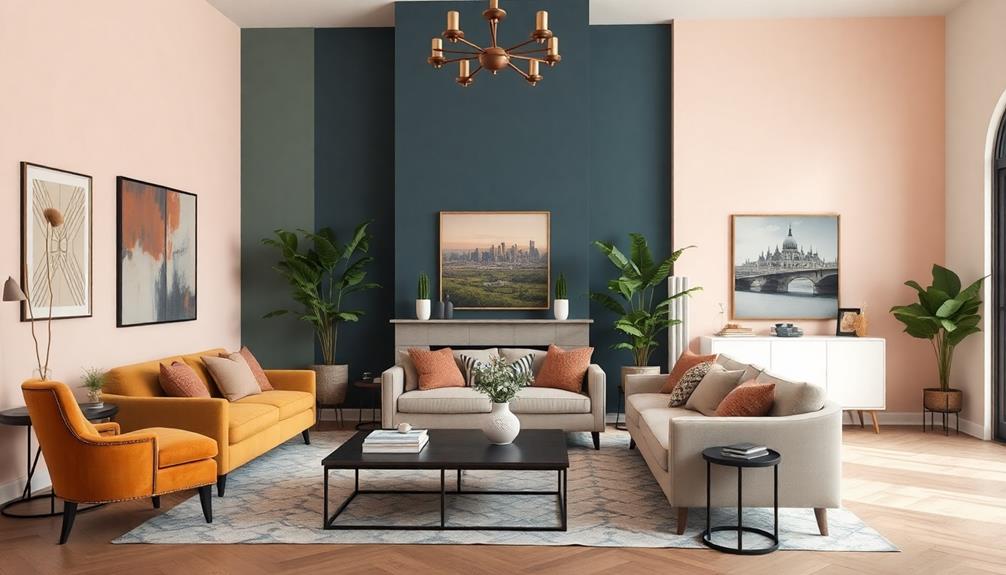
To create a stunning color scheme, start by selecting a palette that resonates with you.
Consider incorporating elements from styles such as coastal color palettes to evoke a serene ambiance or rich tones from dark academia for a more dramatic effect.
Gather inspiration through mood boards and test paint samples to see how they look in your space's lighting.
This hands-on approach guarantees your colors harmonize beautifully throughout your home.
Color Palette Selection
Your home's color palette sets the tone for every space and can reflect your unique personality. Start your color palette selection by creating a mood board. This helps visualize color combinations and guarantees they align with your overall theme and purpose.
Think about your personal style—do you lean towards neutrals, vibrant hues, or a mix of both? Consider the color undertones, as they can drastically change the feel of a room. For instance, incorporating vibrant colors can create an inviting atmosphere, reminiscent of Bedroom Boho Decor Ideas.
Next, research and explore trending palettes on resources like Pinterest or color theory guides. You'll discover unique combinations that can elevate your home design while remaining timeless.
As you choose your colors, aim for a cohesive story throughout your home. Each room's palette should flow seamlessly into the next, creating a harmonious aesthetic.
Testing Paint Samples
Before committing to a color scheme, testing paint samples is essential for making an informed decision. Start by applying larger swatches—at least 12×12 inches—on different walls. This will help you see how the paint colors look in various lighting conditions throughout the day.
Remember, undertones can markedly influence the mood of your space; warm undertones create a cozy atmosphere, while cool undertones evoke calm. To further enhance your home's aesthetic, consider incorporating elements like sustainable home decor materials that align with your chosen color palette.
Here are a few tips for testing paint samples effectively:
- Use a white or neutral primer under your samples for true color reflection.
- Observe how paint colors complement existing design elements by holding samples next to your furniture and decor.
- Consider how the colors interact in different lighting conditions—natural light can alter your perception.
- Document your findings by taking photos of the painted samples throughout the day.
Incorporate Textures and Layers
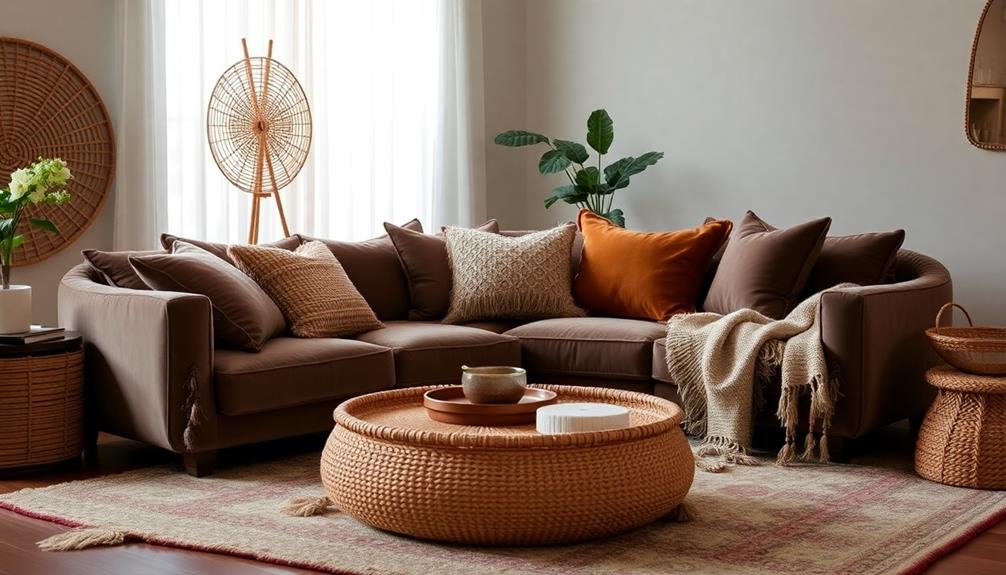
Incorporating a variety of textures and layers can transform a space, making it feel more inviting and dynamic. Start by using different textures like natural stone, distressed leather, and woven fabrics to create depth and visual interest. A jute rug can add warmth and comfort, enhancing the room's overall ambiance.
Emphasizing natural materials that resonate with Balinese design characteristics can further enrich your home's aesthetic.
Layering materials is essential; consider faux-vellum walls paired with soft textiles to create an intimate atmosphere that avoids monotony. Balance is key—mix hard surfaces with soft furnishings to maintain a harmonious environment. This not only guarantees comfort but also enhances aesthetic appeal.
Don't hesitate to experiment with layering. Combining plush cushions, woven throws, and sleek furniture will amplify the tactile experience of your home. This approach brings coziness and warmth, making your space feel lived-in and inviting.
Personalize Your Space

Transforming your home into a personal oasis starts with embracing plush fabrics and rich colors that evoke warmth and comfort. This is your chance to personalize your space, making it a true reflection of your individuality.
Consider adding unique pieces like Indonesian decor masks that represent rich cultural heritage, ensuring every decor choice resonates with your personality.
Use mood boards to visualize your style, ensuring every decor choice resonates with your personality.
Consider incorporating these elements into your design:
- Create your own art or showcase collections that express your passions.
- Mix high-end and low-end items for a curated look that feels authentic.
- Experiment with diverse styles and materials to add depth and interest.
- Focus on comfort by choosing inviting textiles and vibrant hues.
Your home should tell your story, so don't shy away from what makes you unique. By thoughtfully selecting pieces that resonate with you, you'll create an environment that feels both expressive and welcoming.
Optimize Lighting and Ambiance
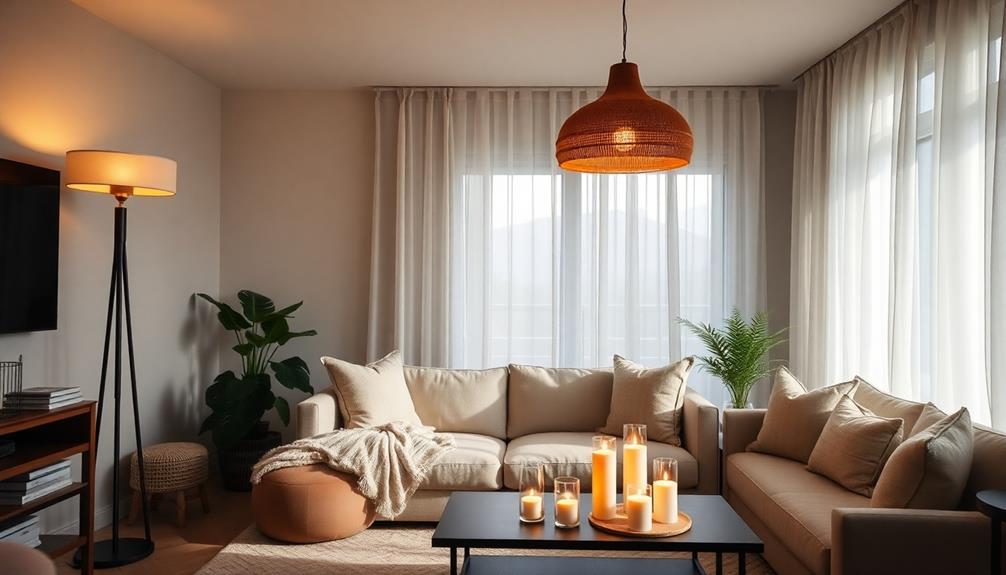
Creating the right lighting can dramatically enhance the ambiance of your home, making it feel warm and inviting. To achieve this, use a combination of task, ambient, and accent lighting. This layered lighting approach adds depth and dimension, making your space feel more dynamic and visually appealing.
Consider utilizing unique decor pieces from local artisans to complement your lighting choices. Opt for soft white bulbs in areas where you want a cozy atmosphere, while daylight bulbs work well in spaces that benefit from a more energizing vibe.
Consider incorporating smart lighting solutions for versatility. These allow you to adjust brightness and color temperature based on your activities or the time of day, enhancing the overall functionality of your space.
Strategically use lighting to highlight your home's design features, such as artwork or architectural details. This not only draws attention to focal points but also elevates your decor, creating a modern and stylish look.
Frequently Asked Questions
How to Decorate Your Home Like an Interior Designer?
To decorate your home like an interior designer, start by crafting a mood board. Select quality furniture, mix textures, layer lighting, and personalize spaces with unique accessories that reflect your style and experiences.
How to Style Like an Interior Designer?
Stylish selection's essential! Start with a mood board to map your vision. Mix materials for depth, balance heights, embrace negative space, and personalize with pieces that tell your story. Your unique style shines through!
How to Develop Your Own Interior Design Style?
To develop your own interior design style, reflect on your past experiences, identify your preferences, research various aesthetics, and experiment with mixing styles. Collaborate with designers to create a cohesive space that represents you authentically.
How to Decide Home Décor Style?
When deciding your home décor style, think about what resonates with you. Reflect on your likes, dislikes, and past experiences. Combine influences, explore online tools, and let your unique aesthetic shine through!
Conclusion
By following these steps, you'll transform your home into a stylish sanctuary that reflects your personality. Think of your space like a blank canvas; each choice adds color and depth to your masterpiece. Don't be afraid to experiment and let your creativity shine through! Remember, the key to great design lies in balance and harmony. Embrace your unique style, and soon you'll feel like an interior decor expert right in your own home.
